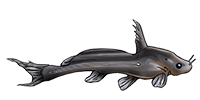Live aquaria.com is selling a pleco as:
Thomasi (L-188a) Plecostomus (Chaetostoma thomasi)
Looks different than the L188 here. Am I missing something? -Barry
I.D. help, please
-
b.reder
- Posts: 137
- Joined: 31 May 2016, 03:47
- I've donated: $50.00!
- My cats species list: 3 (i:0, k:0)
- Location 1: San Diego
- Location 2: Calif.
- bekateen
- Posts: 9647
- Joined: 09 Sep 2014, 17:50
- I've donated: $40.00!
- My articles: 4
- My images: 143
- My cats species list: 146 (i:106, k:34)
- My aquaria list: 37 (i:14)
- My BLogs: 44 (i:154, p:2563)
- My Wishlist: 36
- Spotted: 184
- Location 1: USA, California, Stockton
- Location 2: USA, California, Stockton
- Contact:
Re: I.D. help, please
Hi Barry,
No, you aren't missing something, they are... a brain:
In fact, little did you know, but there are two problems here: (1) The identity of the fish in the photo (and presumably the identity of the fish for sale), and (2) the proper relationship between the species name and the L number. Both are complicated stories.
The first problem is that most wholesalers and retailers are horrible at ID'ing or labeling the fish they sell. The fish pictured on that website is .
In fact, there is no such thing as Chaetostoma thomasi. That name first appeared as an accidental misspelling of , and to this day it is very commonly used by stores and in some books.
Another problem is that the fish being sold as C. thomasi (or as C. thomsoni when the stores are careful enough to spell the name right) aren't even C. thomsoni. That species lives on the western side of the Andes, but the fish you are seeing in stores are getting collected on the eastern side of the mountains, from a different drainage. The species found in the area where these are being exported include C. formosae, , and (often called ; C. joropo was described only recently, so for now L445 still persists in the database here as a separate species; eventually, the two entries will most likely get combined as C. joropo).
To confound matters more, many retailers receive C. formosae mixed with C. dorsale in a single order (often in a 50-50 ratio). For example, see this old thread:
Mystery Chaetostoma, impulse buy at PetSmart
The second problem has to do with the proper assignment of L numbers. There have been several misuses and reuses of L numbers, leading to what you observed - that two different fish might be called by the same L number. See these articles for explanations:
So if you are trying to buy some it's best not to order them sight-unseen, but examine the fish in a store and ensure you aren't getting a mix of two species (unless you want both species, LOL)
Cheers, Eric
No, you aren't missing something, they are... a brain:
In fact, little did you know, but there are two problems here: (1) The identity of the fish in the photo (and presumably the identity of the fish for sale), and (2) the proper relationship between the species name and the L number. Both are complicated stories.
The first problem is that most wholesalers and retailers are horrible at ID'ing or labeling the fish they sell. The fish pictured on that website is .
In fact, there is no such thing as Chaetostoma thomasi. That name first appeared as an accidental misspelling of , and to this day it is very commonly used by stores and in some books.
Another problem is that the fish being sold as C. thomasi (or as C. thomsoni when the stores are careful enough to spell the name right) aren't even C. thomsoni. That species lives on the western side of the Andes, but the fish you are seeing in stores are getting collected on the eastern side of the mountains, from a different drainage. The species found in the area where these are being exported include C. formosae, , and (often called ; C. joropo was described only recently, so for now L445 still persists in the database here as a separate species; eventually, the two entries will most likely get combined as C. joropo).
To confound matters more, many retailers receive C. formosae mixed with C. dorsale in a single order (often in a 50-50 ratio). For example, see this old thread:
Mystery Chaetostoma, impulse buy at PetSmart
The second problem has to do with the proper assignment of L numbers. There have been several misuses and reuses of L numbers, leading to what you observed - that two different fish might be called by the same L number. See these articles for explanations:
So if you are trying to buy some it's best not to order them sight-unseen, but examine the fish in a store and ensure you aren't getting a mix of two species (unless you want both species, LOL)
Cheers, Eric
Find me on YouTube & Facebook: http://youtube.com/user/Bekateen1; https://www.facebook.com/Bekateen
Buying caves from https://plecocaves.com? Plecocaves sponsor Bekateen's Fishroom. Use coupon code bekateen for 15% off your order. Also, for you Swifties: Https://youtu.be/ZUKdhXL3NCw
-
b.reder
- Posts: 137
- Joined: 31 May 2016, 03:47
- I've donated: $50.00!
- My cats species list: 3 (i:0, k:0)
- Location 1: San Diego
- Location 2: Calif.
Re: I.D. help, please
Eric- Thank you! You are a fountain or stream, maybe even a river of knowledge! -Barry









